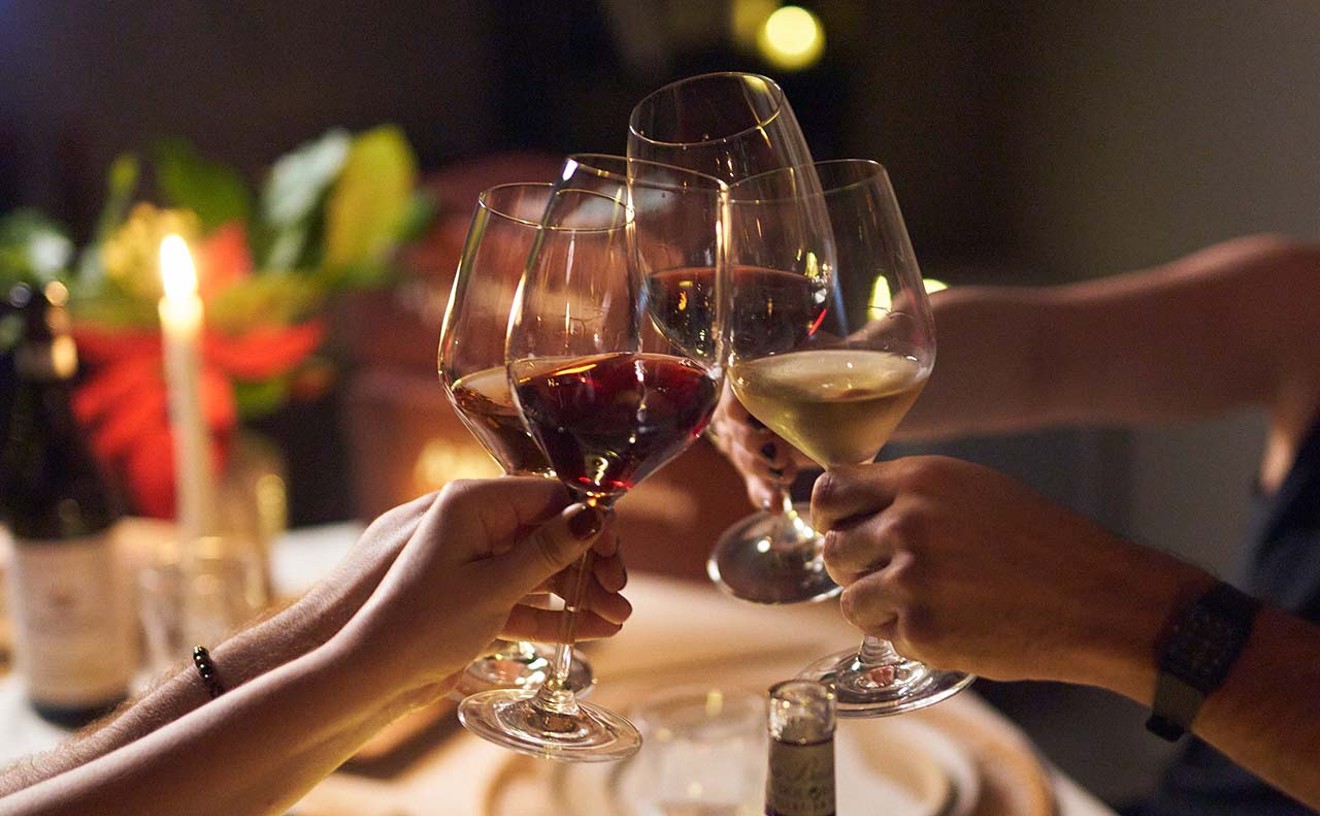The noodle notion is the no-brainer of the two. Some years ago I returned to my former West Village neighborhood in New York City and discovered that nearly a whole block of stores had been taken over by one single business, the succession of signs on the street reading Ollie's Noodle Shop Ollie's Noodle Shop Ollie's Noodle Shop Ollie's Noodle Shop Ollie's Noodle Shop. Noodles are enormously popular in cities throughout the world, so it's about time someone used his noodle and opened a shop here.
This one is as basic as they come. Stools wrap around a counter behind which a couple of cooks fling ramen, udon, rice, and soba noodles into water and then into woks. A few more stools are lined up at another counter across the small room, and old-timey print ads of smiling Asian gals are pasted on the ceiling. It's very cozy.
Also simple is the menu, a concise list of mix-and-match options scrawled on a chalkboard hanging on the wall. There are just four appetizers: mixed green salad, edamame sprinkled with sea salt, a trio of crunchily fried chicken wings with neon-orange sweet/spicy sauce, and four pork dumplings (gyoza). Our waiter assured us the last came boiled or pan-fried, but they arrived deep-fried, dark and brittle.
Anyway, forget the starters — the Noodle Shop is about the noodles, all firm, toothsome, and less than $10 per bowl. Some are thin and squiggly and made from egg (ramen); some spaghettilike and composed of buckwheat (soba); others are flat and translucent (rice); and my favorite are the very thick, chewy, ivory-color, wheat-based udon. You select your noodle; choose whether you want it in soup, stir-fried, or chilled; and then pick a garnish — pork, chicken, tofu, or the best of the lot, a feathery-light shrimp tempura. Mark down your combo on a paper scorecard, like at dim sum, and wait for the steamy bowls to arrive. A big silver can of chilled Sapporo beer is available to enhance your waiting pleasure.
I found the dashi-mirin base of the soups a bit too salty from shoyu (Japanese soy sauce), but stir-fries were splendid, especially barbecue pork ramen speckled with crisp bits of garlic. Pad thai brought limp, insipidly seasoned rice noodles, which I'm convinced would have come out better if the cook had not been distractedly chatting away on his cell phone while preparing it. Overall the Noodle Shop is a cool lunch stop with oodles of charm, but an ominous notice mars the menu: "Sushi coming soon!" I suggest you eat here before this surely ruinous event occurs.
The kushiyaki concept behind O Asian Grill represents a riskier roll of the dice. Diners in this country are less familiar with kushiyaki than with yakitori, which originally consisted only of its namesake chicken parts but nowadays pretty much refers to any kebab with an Asian marinade. The word kushiyaki translates to "skewer grill" and is basically any kebab without a marinade — therein the risk, in that the nakedness of skewered meat, fish, or vegetables is alien to the American taste for big-flavor barbecue. Another unique aspect to this Japanese style of grilling is the use of ultrahard bincho-tan charcoal from Wakayama, which burns long, clean, and hot at 1200 degrees. (American charcoal tops out around 800 degrees.)
O Asian Grill also offers robatayaki items, differentiated from kushiyaki in that they're not skewered. It would have been cool had Pooch and the party guys gone all the way and set up a real Japanese robata, which traditionally has customers sitting around a horseshoe-shape bar with a hearth in the center while they point to and shout out the ingredients they want placed on the grill, and the robata chefs passing the finished products out on wooden oars (a symbolic nod to the original Japanese grillers, fishermen cooking their catch over open fire).
At O, a wall of glass separates the grill cooks and the diners, and no one is shouting. Which is not to say things are quiet. As evening becomes late night, the downstairs club fills with festive carousers sucking down cocktails amid cascading red lights, mirrors, and thumping, thuggish club music. Sitting at one of the skybox cubicles overlooking the scene reaps people-watching benefits, but dine early if you want to hear anything your dinnermates say.
Unlike SoBe club action, bincho-tan coal hardly smokes. Thus very little smoke flavor penetrates the food, which doesn't touch the grill, either, because skewers are placed across narrow rectangular boxes elevated above the grates. In the Far East, pristine ingredients are used in this process, most notably prime, fatty cuts of beef and other foods whose flavors are full enough to speak for themselves — remember, no marinades or glazes; just salt, pepper, and occasionally a squeeze of lemon. Problem is, many of the items here were not all that fatty or prime. Chicken breast came skewered two ways — plain and plain with scallions. Both were bland and dry. Chilean sea bass was dull as well, and ditto the salmon, the shishito pepper, and the shrimp-and-tomato. All desperately needed to be dipped into one of three accompanying sauces served for just this purpose: a fruity and very spicy soy; a moderately hot red Thai curry; and a mild ponzu.
On the plus side, kebabs of prime rib, bacon-wrapped cherry tomatoes, chicken meatballs (tsukune), and skinny, frankfurterlike pork sausage were moist and quite tasty. Skewers are available à la carte, most from $3 to $6 (washu steak, a mixed breed of Kobe beef and Black Angus, goes for $12), but it makes more sense to get a six-, eight-, or ten-pack combo for $18 to $32 — not only a better deal but also ordering this way requires fewer trips to the table and thus less potential for messups by the sluggish, inattentive waitstaff.
Not everything comes on a skewer. Chef Teruhiko Iwasaki, former honcho at Hollywood's Sushi Room, serves sparkling sashimi selections — from yellowtail with radish-jalapeño salsa to white fish with plum vinegar and basil oil. Other tempting starters include Manila clams steamed with soy and sake in a heated ceramic bowl (toban), and two grilled patties of rice capped with a cooked combo of tuna, yellowtail, whitefish, and smoky salmon, all bound in spicy mayonnaise.
Three small-plate entrée "specialties" are likewise fetching: free-range teriyaki chicken over foie gras fried rice; sea bass steamed with truffles over green tea soba noodles; and the obligatory homage to Nobu, a terrifically rich, buttery parcel of black cod lacquered and bolstered by roasted peanut-and-miso glaze.
A petite cup of custard made from yuzu (a sour Japanese citrus fruit) tasted like key lime pie filling, which wasn't bad alongside a mélange of three berries (black, blue, and rasp). As for the other desserts — you'd think that men who make their living via over-the-top party schemes could come up with more innovative postdinner creations than molten chocolate cake and key lime pie. Then again, there are only so many new tricks you can squeeze from old scenesters, so I suppose we should be appreciative that at least some of the ones they try here seem to be working out pretty well.











